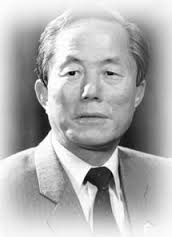History
Translated literally, Tae Kwon-do means "Art of Hand and Foot Fighting". It is more than that however. It is the scientific use of the body in methods of self defence, a body that has gained the ultimate use of it's facilities through intensive physical training. It is a martial art. It's discipline, techniques and mental training are mortar for building a strong sense of justice, fortitude, humility and resolve. It is this mental conditioning that separates the true practitioner from the sensationalist, content with mastering only the fighting aspects of the art.
The name Tae Kwon-do as every student knows, did not exist until April 11 1955, when at a meeting of leading Masters, distinguished Historians and Politicians, General Choi Hong Hi, 9th Degree (1918-2002) pictured left, submitted the name Tae Kwon-do and the syllabus of his art. This was unanimously accepted and also received the approval of the Korean President. Therefore unifying the various Kwan's such as Dong Soo, Gong Soo, Kwan Bup, Tae Kyon, Soo Bak, Kang Soo and others.
What led to this?
Korea's first known and historically documented system of fighting
techniques were practiced and 600AD in the Silla Kingdom (Southern
Korea). These ancient and primitive techniques were systemised
into a style known as Soo Bak-Gi. This was shortly followed by Tae
Kyon (known as the Korean Art of Foot Fighting) which was used
extensively by early dynasties for recruiting and training their armed
forces.
It was during the Koryo Dynasty that it became a formulated system
consisting of some 25 basic leg movements, which included leg and hand
techniques as well as jumps, rolls and falls. However, these arts
were to decline during later dynasties as an anti-military position was
adopted. Further decline was to follow in 1909 when Korea became a
nation occupied by the Japanese, who outlawed the practice of Tae Kyon
along with many other Korean customs and traditions.
Tae Kyon was only to survive due to the efforts of people like Masters Song Duk Ki and Han II Dong who would not let their heritage die. In 1933, a young General Choi was sent by his father to learn the art of calligraphy. His teacher was Han II dong, who since the occupation had practised his art (Tae Kyon) relentlessly but in secret. On seeing the small frail looking boy, Master Han decided not only to teach him calligraphy but also Tae Kyon. For the next few years General Choi was to practice Tae Kyon under the watchful eye of Master Han. Then in 1937 General Choi was sent to Kyoto, Japan to further his education. While there, he studied Karate under a fellow Korean Mr Kim attaining a 2nd Degree Black Belt.
On returning to Korea during World War II, General Choi like so many of his countrymen was forced to enlist the Japanese Army, but while posted at Pyongyang he was implicated as a planner of the Korean Independence movement and sent to a Japanese Prison. While there he started to lay the foundation of the new art, teaching his fellow inmates. 1945 saw the end of the war and with it the liberation of Korea and the release of General Choi from prison. In January 1946 General Choi became a 2nd Lieutenant in the newly formed Korean Army. Later he was assigned to Kwang-Ju as a Company Commander. While there, he taught the whole company the foundation of the new art.
On being promoted to 1st Lieutenant he was sent to Tae Jan where he not only taught Koreans but also American Troops stationed there. The next few years saw General Choi consolidating the basic foundations of Tae Kwon-do while pursuing his military career. By 1949 he had attained the rank of full Colonel and with it the opportunity to go to study at the Fort Riley Grand General School inn Kansas USA. While there he gave America it's first taste of Tae Kwon-do
The years to 1953 saw General Choi organise the Korean Grand General School in Pusan. As Assistant Commandment and Chief of the Academic Department of 1952 he briefed General MacArthur on his visit to Kang Numg and at the time of the armastice he was in command of the 5th Infantry Division.
In 1954 General Choi activated the 29th Infantry Division at the Cheuj Island and the Oh Do Kwon (Gym of My Way). While there, along with Major Nam Tae Hi, he was also commander of the Chon Do Kwan (Gym of the Blue Wave) which was the largest of the civilian gyms.

General Choi Hong Hi
9th Degree (1918-2002)
April 11 1955 saw the Tae Kwon formally recognised in Korea.
But this was only the beginning as General Choi was about to teach Tae Kwon-do to the world.
